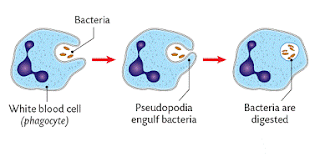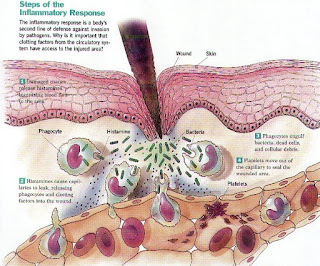BioTechnology | Immune System
INNATE/ NATURAL IMMUNITY
INNATE/ NATURAL IMMUNITY
(OUR BODY’S FIRST LINE
OF DEFENCE)
Can
Immunity be Natural?
What
is Innate Immunity or Natural Immunity in Bio Technology?
This post will clear your all doubt and logic on Innate/
Natural Immunity; I have tried to structure this post as SPECIAL NOTES LIKE feel to give
more insight and increase readability.
In the previous post https://deepalitalk.blogspot.com/2019/06/immune-system-basic-concepts-your.html, I have explained some important terms
related to our immune system which
will help you in understanding the topic further.
Our body has a mechanism to defend itself against “foreign bodies” which is broadly termed
as Immunity.
These “foreign
bodies” are dust, infections and
might be cancer cells.
·
Ideally Immunity is of two types,
A)
Innate
Immunity
B)
Adaptive
Immunity
The above diagram gives us the first picture of both
types of Immunity.
The innate process works as a “Hare” in our body in providing immunity
while adaptive immunity process works slowly and steadily just like a
“Tortoise”.
Now we will look into the innate immunity working
process.
INNATE
IMMUNITY:
A person is born
with this type of immunity, so commonly it is also called as Natural
Immunity.
Function-
It gives an immediate defense against
infections and is found in all plant and
animal life.
Behavior- This Immunity is
not adaptable and does not change
with the individual’s lifetime.
·
Innate Immunity acts defensive in four different ways:
A)
Anatomical
Barrier
B)
Physiological
Barrier
C)
Phagocytic
Barrier
D) Inflammatory Barrier
A) Anatomical Barrier:
Points to Remember:
·
The
foremost and the basic barrier is the skin.
·
The
outer layers of the skin are known as “Epithelial
cells”.
·
They
form a waxy layer which keeps out the
infectious agents.
·
These
cells are the innate immune system's first
line of defense against infectious foreign organisms.
·
The
skin internally is present as the lining of the intestine and lung.
·
In
the intestines or lungs, movement caused by peristalsis or cilia brush up the infectious agents.
·
Mucus also provides immunity by trapping
the infectious agents.
·
In
the intestines, gut flora prevent pathogenic bacteria by
secreting toxic substances, or compete
with pathogenic bacteria to attach on the cell
surfaces.
Sometimes
crying and food cravings work in our favor, because of the flushing action which makes tears and saliva to prevent infection
of the eyes and mouth.
B)
Physiological Barrier:
Points to Remember:
·
Our
body physiology is designed in such a
way that whenever an infectious organism
is there in our body, it starts working in such away to eliminate the pathogen
from our body.
·
The
most common is fever response. It
stops the growth of micro organism by raising the body temperature which is not
suitable for growth of pathogens.
·
The
acidic environment of stomach and
vagina also retard the growth of invading organisms.
·
The
pH of urine being 6.0 is inhibitory in nature for any kind
of microbial growth.
·
Several
chemical mediators work in response
to provide immunity.
·
The
lysozyme of tears breaks off the
bacterial cell wall while interferons
induce an antiviral state in
uninfected cells.
·
The
Complement system facilitates phagocytosis. Both the terms play an very important role in immune
system and will be discussed in upcoming
posts.
·
The
antibacterial peptides kill the
pathogenic bacteria.
C)
Phagocytic Barrier:
The term “phagocyte” refers to "eating cell”.
The
process is simply explained in three steps:
1.
A phagocyte extends a portion of its
plasma membrane around the pathogen until the particle is inside the cell.
2.
The pathogen is inside an endosome
which merges with a lysosome.
3.
The enzymes and acid present in lysosome
digest or kill the pathogen.
Points to Remember:
·
The
most important feature of phagocytes
is the ability to react with a highly
specialized molecular signals produced by other cells called cytokines.
·
The
phagocytic process play an important
role in regular tissue development and maintenance
and is an important part in healing
process.
·
The
phagocytic cells of immune system
comprises of macrophages, neutrophils and
dendritic cells.
D)
Inflammatory Barrier:
Points to Remember:
- Inflammation is the immune system response to pathogens stimulated by chemicals released from injured cells.
- It
is the physical barrier against spread of infection and heals damage tissue after the clearance of pathogens.
- Chemicals produced during inflammation attract phagocytes or precisely neutrophils which trigger other parts of immune system.
These four
barriers constitute the innate or natural immune response in our body, but some
cells are also involved in evoking immune response in our body and are compiled
in the first line of defense immune system.
These
cells are as following:
i)
Mast cells
ii)
Phagocytes (Macrophages,
Neutrophils, Dendritic cells)
iii)
Basophils and Eosinophils
iv)
Natural killer cells
This comprises
Innate immunity Part-I and in
the next post, I am going to explain readers a complete glance of the above mentioned cells of immune system.
Please share and comment your thoughts and doubts.
Happy Bio Technology Learning & Good Luck!!!









No comments:
Post a Comment